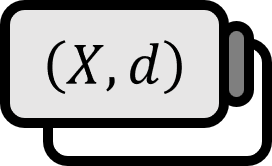Borel-Cantelli Lemma
Theorem
Distance spaces $(X, \rho)$ satisfy all of the following equivalent conditions.
(a) $X$ is a compact space.
(b) $X$ is sequentially compact.
(c) $X$ is both a complete space and a totally bounded space.
Description
A sequentially compact space in distance spaces $X$ means that every sequence in $X$ has a subsequence that converges to a point within $X$. The Borel-Lebesgue theorem provides several necessary and sufficient conditions for compactness in distance spaces. However, this name is not very famous, and it is often simply introduced as a condition of compactness in distance spaces.
Proof
(a) $\implies$ (b)
Suppose that a sequence $\left\{ x_n \right\}_{n \in \mathbb{N}}$ defined in $X$ does not have a convergent subsequence. Then, for every $i \ne j$, there exists an open neighborhood $\mathcal{N}(x_{i})$ satisfying $x_{j} \notin \mathcal{N} (x_{i})$ for $x_{i}$. Since $\mathcal{N}_{0} := X \setminus \left\{ x_{n} \right\}$ is an open set, $\left\{ \mathcal{N}_{0} \right\} \cup \left\{ \mathcal{N}(x_{n}) : n \in \mathbb{N} \right\}$ is an open cover of $X$, but any finite subcover of this would necessarily miss infinitely many points of $\left\{ x_{n} \right\}$. This contradicts the assumption that $X$ is compact.
(b) $\implies$ (c)
First, let’s prove that $X$ is complete.
Suppose $\left\{ x_n \right\}_{n \in \mathbb{N}}$ is a Cauchy sequence defined in $X$. If $X$ is sequentially compact, then the sequence $\left\{ x_n \right\}_{n \in \mathbb{N}}$ has a converging subsequence $\left\{ x_{n_{k}} \right\}_{k \in \mathbb{N}}$. In other words, for some $x \in X$ when $k \to \infty$, and given $\varepsilon >0$, choose $N \in \mathbb{N}$ large enough so that $\rho (x_{i}, x_{j}) < \varepsilon / 2$ holds for any $i, j \ge N$. Then set $n_{k} \ge N$ so that
$$ \begin{align*} \rho (x,x_{N}) \le & \rho (x,x_{n_{k}}) + \rho (x_{n_{k}} , x_{N}) \\ =& \varepsilon/2 + \varepsilon/2 \\ =& \varepsilon \end{align*} $$
Thus, $X$ is a complete space. Now, to prove that $X$ is totally bounded, suppose that $X$ cannot be covered by a finite number of balls with radius $\varepsilon$. Let’s consider a sequence $\left\{ x_n \right\}_{n \in \mathbb{N}}$ as follows:
$$ x_{1} \in X \\ x_{2} \in X \setminus B_{\rho}(x_{1};\varepsilon) \\ x_{3} \in X \setminus B_{\rho}(x_{1};\varepsilon) \setminus B_{\rho}(x_{2} ; \varepsilon) \\ \vdots $$
This sequence does not have a converging subsequence, so it contradicts the assumption that $X$ is sequentially compact. Therefore, $X$ must be totally bounded.
(c) $\implies$ (b)
Because $X$ is totally bounded, for every $n \in \mathbb{N}$ there exists a finite set of sequences $S_{n}:= \left\{ y_{1}^{(n)}, \cdots , y_{k_{n}}^{(n)} \right\}$ that
$$ X \subset B_{\rho} \left( y_{1}^{(n)} ; {{ 1 } \over { n }} \right) \cup \cdots \cup B_{\rho} \left( y_{k_{n}}^{(n)} ; {{ 1 } \over { n }} \right) $$
Meet the criteria. Now, for any arbitrary sequence $\left\{ x_n \right\}_{n \in \mathbb{N}}$ defined in $X$, we try to find a converging subsequence $\left\{ z_n \right\}_{n \in \mathbb{N}}$ as follows.
$S_{1}$ being a finite set, allows us to pinpoint the last element $y_{k_{1}}^{(1)}$, and $ B_{\rho} \left( y_{k_{1}}^{(1)} ; {{ 1 } \over { 1 }} \right)$ contains infinitely many points of $\left\{ x_n \right\}_{n \in \mathbb{N}}$. Choose one to define $z_{1} \in B_{\rho} \left( y_{k_{1}}^{(1)} ; {{ 1 } \over { 1 }} \right)$. Likewise, since $s_{2}$ is a finite set, we can determine the last element $y_{k_{2}}^{(2)}$, and similarly define $z_{2} \in B_{\rho} \left( y_{k_{1}}^{(1)} ; {{ 1 } \over { 1 }} \right) \cap B_{\rho} \left( y_{k_{2}}^{(2)} ; {{ 1 } \over { 2 }} \right)$. By selecting $\displaystyle z_{k} \in \bigcap_{i=1}^{m} B_{\rho} \left( y_{k_{i}}^{(i)} ; {{ 1 } \over { m }}\right)$ for every $m \in \mathbb{N}$, $\left\{ z_{n} \right\}$ naturally becomes a Cauchy sequence. Since $X$ is complete, $z_{n}$ converges to a point in $X$. Therefore, having shown that any arbitrary sequence $\left\{ x_n \right\}_{n \in \mathbb{N}}$ has a converging subsequence $\left\{ z_n \right\}_{n \in \mathbb{N}}$, $X$ is sequentially compact.
(b) $\implies$ (a)
Given the open cover $\left\{ U_{i} : i \in I \right\}$ and $r>0$ of $X$, suppose for all $i \in I$ there exists $x \in X$ that satisfies $B_{\rho} (x; r) \nsubseteq U_{i}$. Then, one can pick a sequence $\left\{ x_n \right\}_{n \in \mathbb{N}}$ that satisfies $B_{\rho}(x_{n} ; 1/n) \nsubseteq U_{i}$ for all $i \in I$. The fact that $X$ is sequentially compact means the sequence $\left\{ x_n \right\}_{n \in \mathbb{N}}$ has a converging subsequence $\left\{ x_{n_{k}} \right\}_{k \in \mathbb{N}}$. That is, for some $x \in X$ when $k \to \infty$, there will be an open set $U_{i_{0}}$ that $x$ belongs to. Since $U_{i_{0}}$ is an open set, there exists $r_{0}$ satisfying $B_{\rho} (x ; r_{0}) \subseteq U_{i_{0}}$. Now, choose a sufficiently large natural number $N \in \mathbb{N}$ to meet $\rho (x , x_{N}) < r_{0} / 2$ and $1/N < r_{0}/2$. If $y \in B_{\rho} (x_{N} ; 1/N)$, then
$$ \begin{align*} \rho (x,y) \le & \rho (x,x_{N}) + \rho (x_{N},y) \\ <& r_{0}/2 + r_{0}/2 \\ =& r_{0} \end{align*} $$
It leads to $y \in B_{\rho} (x; r_{0}) \subseteq U_{i_{0}}$. Hence,
$$ B_{\rho} (x_{N} ; 1/N) \subseteq B_{\rho} (x; r_{0}) \subseteq U_{i_{0}} $$
This is a contradiction, meaning that for all $x \in X$, there must exist some $i \in I$ that satisfies $B_{\rho}(x,r) \subseteq U_{i}$ with $r>0$. Since it has been shown in (b) $\implies$ (c) that a sequentially compact space is totally bounded, it follows that there exist finitely many points $y_{1} , \cdots , y_{n} \in X$ that satisfy $\displaystyle X \subset \bigcup_{i=1}^{n} B_{\rho}(y_{1} ; r)$. Of course, each $y_{i}$ is such that $B_{r}(y_{i}) \subset U_{k_{i}}$ for some $k_{i} \in I$, thus $\left\{ U_{k_{1}} , \cdots , U_{k_{n}} \right\}$ is a finite subcover of the open cover $\left\{ U_{i} : i \in I \right\}$. Hence, $X$ is compact.
■
